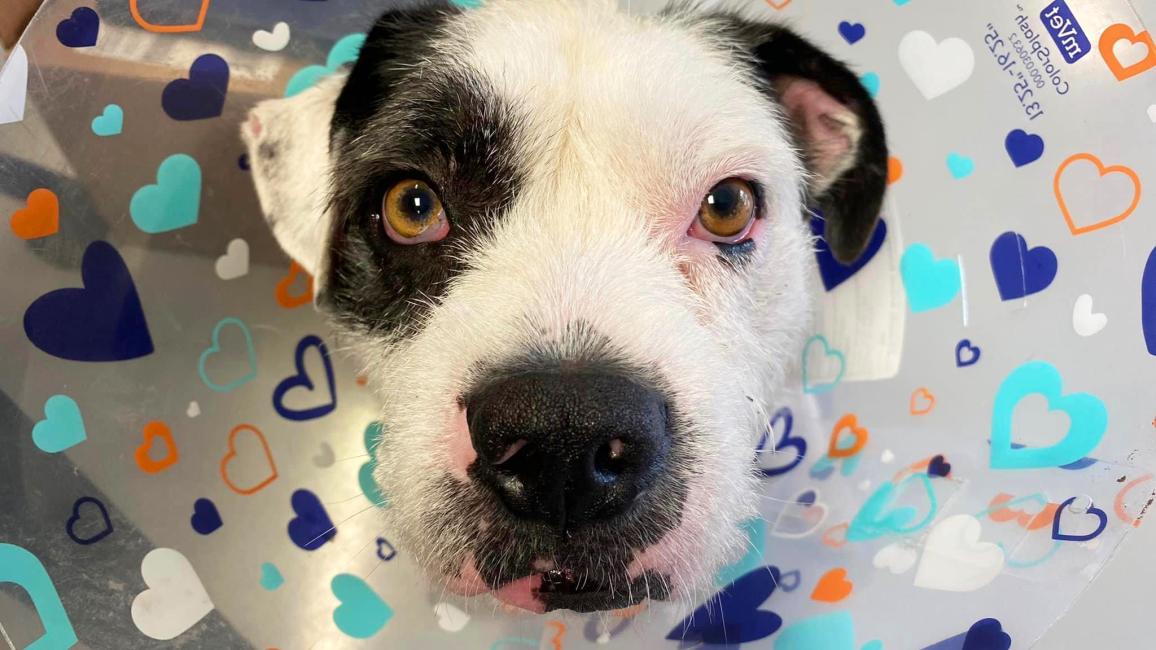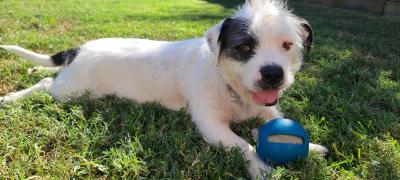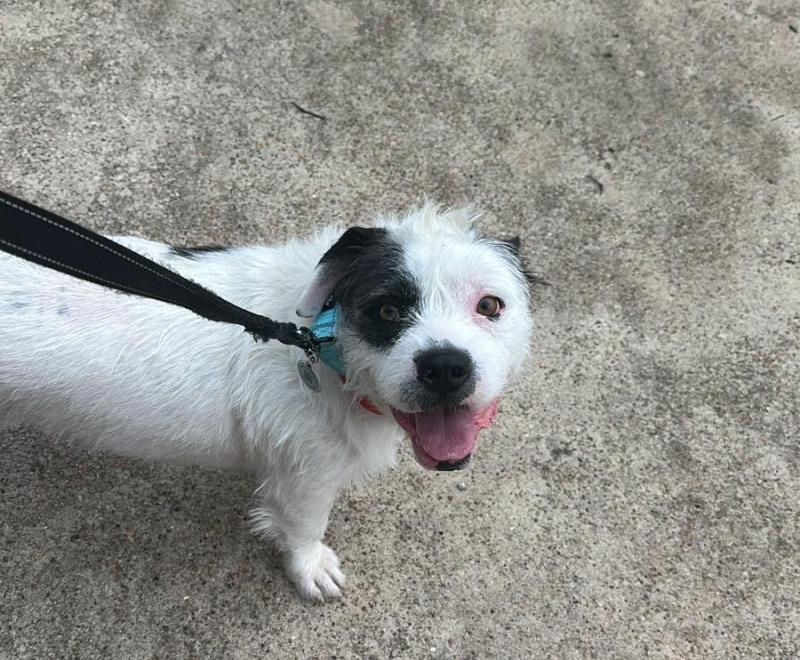Rexie the ‘T. rex’ pup loves life in his new home

If you saw a white blocky-headed, scruffy-haired low rider of a dog with one black eye scooting down a Houston street last summer, it might have been Rexie. And if you couldn’t spot much airspace between the bottom of his belly and the ground, then forget about it: It had to be Rexie.
When Rexie arrived at Best Friends’ Houston headquarters, he was scanned for a microchip and checked by the veterinary staff. Animal shelters in the area were alerted in case someone was looking for him. Posters were placed around town.
Valentina Costa, senior lifesaving outcomes coordinator for Best Friends, remembers Rexie’s inimitable physique: “His appearance in general was very unique. He just kind of waddled over to you, got his sniffs in, and then wagged his tail and enjoyed all the attention he got from the staff.”
Rexie also showed he was quite mellow — so much so that caregivers wondered whether there might be something medically wrong that caused him to have such a calm demeanor. A thorough examination did reveal that he was bothered by skin allergies, but there was something else. He had heartworm disease, a serious condition that can be fatal if left untreated.
Rexie is a dog who could have been at risk of being killed in a shelter, especially if that shelter were already full and struggling to save healthy dogs and cats. Best Friends’ goal is for all shelters to reach no-kill by 2025, and that means supporting them with programs and partnerships that help pets and their people. In Rexie’s case, he needed heartworm treatment, which is expensive and takes several weeks, to save his life.

Time for a new best friend
Chris and Jessica Schwark had been thinking about adding a new family member after losing Max, their beloved white terrier-type dog who was part of their family for 15 years. Knowing they were looking for a new best friend, Deyra Galvan, Best Friends’ manager of lifesaving programs who knows the couple, called to see whether they’d be interested in fostering Rexie.
“We went to see him at the Best Friends office,” says Chris. “We liked him and decided to foster him right away.”
Chris and Jessica had been without a dog for a year and a half. They wanted to ease back into the prospects of bringing home a new family member. And caring for the dog while he underwent heartworm treatment was a great opportunity to do just that. The treatment would involve several visits to the vet and close monitoring to watch for complications.
[6 unexpected benefits of fostering a dog during heartworm treatment]
Having people around who can provide a dog with love, care, and all the comforts of a home is desirable for dogs undergoing heartworm treatment. Keeping them relaxed and happy is critical to a successful recovery.
Rexie also proved to be a super laid-back dude, and that was a good thing during heartworm treatment, which requires that dogs’ physical activity be restricted. But every once in a while, he’d show Chris and Jessica a little burst of energy, usually accompanied by a nimble bunny hop forward.
Good-natured and friendly from the get-go, he let Chris and Jessica know right away what he liked best: stuffed animals. In fact, Rexie always seemed to have a stuffie in his mouth, in particular his purple rainbow fish, which, Valentina says, “He loved to pieces.”

The perfect little ‘T. rex’
As time passed, despite putting out the word, no one came in to claim Rexie, who by then had made significant progress charming his way into the family. To Chris and Jessica, the handwriting was on the wall: The curly-headed white dog with one black eye was already home. And he had already picked up a new name: Rexie.
“To us, he’s so low to the ground and with his short arms and big head, he’s our little Tyrannosaurus rex,” Jessica says. “And when he gets his squeaky tennis ball and wants you to play with him, he’ll let out this little roar.”
On long walks, Rexie loves to take his stuffed animals along for the ride. In fact, he never goes anywhere without a stuffed toy in his mouth. Toys are like a security blanket to him, says Jessica.
[Dog becomes a foster win in the sweetest way]
Of all the things they like about Rexie, it’s his laid-back style that melds perfectly with Chris and Jessica’s lifestyle. And after having fostered some high-energy dogs in the past, they find Rexie’s calm nature refreshing. “He’s really good at taking it easy,” says Jessica. “He likes to sleep in and lie out in the yard. He’s very affectionate — a great chill dog. He was such a joy to have with us.”
Occasional bursts of energy will turn into zoomies out in the backyard. He likes long walks and playing fetch with tennis balls. And if you’re close by, he’ll nudge you after being petted so that you’ll do it again. At 40 pounds, he’s also a bit of a chowhound. “He’s right there on the dot at dinnertime,” she says.
Chris and Jessica say they weren’t really sure whether they were ready to adopt, but fostering Rexie won them over. “Our experience taking care of Rexie through his heartworm treatment pushed us toward making the decision,” says Chris. “We’re so glad we did. He is such a perfect fit.”

Let's make every shelter and every community no-kill by 2025
Our goal at Best Friends is to support all animal shelters in the U.S. in reaching no-kill by 2025. No-kill means saving every dog and cat in a shelter who can be saved, accounting for community safety and good quality of life for pets.
Shelter staff can’t do it alone. Saving animals in shelters is everyone’s responsibility, and it takes support and participation from the community. No-kill is possible when we work together thoughtfully, honestly, and collaboratively.






